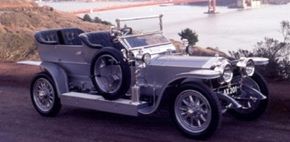Henry Royce probably did not start out to create the "Best Car in the World" when he designed the Rolls-Royce Silver Ghost. What he wanted was to replace his rough-running six-cylinder "Thirty" with something more reliable, something smoother and quieter.
He succeeded so completely that the new car, introduced at the Olympia Motor Show and later named Silver Ghost, became the longest-running single model next to the Model T Ford (and, much later, the VW Beetle and the British Mini) -- and certainly the most famous luxury car in history. The Silver Ghost remains to this day the most desirable model among antique (pre-1930) cars.
Advertisement
Rolls-Royce, founded in Manchester in 1904, was the amalgam of socialite entrepreneur Charles S. Rolls, who'd been selling Panhards and wanted something better, and the aforementioned Mr. Royce, whose previous experience had been with electric cranes.
Early production involved a variety of cars in different sizes with two, three, four, and six cylinders, about as successful as bystanders expected from this unlikely duo. But those who thought the venture would fail did not reckon on Royce's acumen, nor his single-minded determination to build a better car than anybody else.
The Silver Ghost was renowned for its smooth, quiet running, achieved with a massive, seven-main-bearing crankshaft and stiff crankcase. Its cylinders were cast in two blocks of three, inclusive of heads, which eliminated head gaskets and the chances of their blowing. The specifications included full-pressure lubrication, an electrical system that really worked, and a precision carburetor made with the quality of a Swiss watch. Its reliability, at a time when "horseless carriages" were anything but reliable, was legendary.
This was proven when a Silver Ghost emerged from a 15,000-mile trial in 1907, observed by the Royal Automobile Club, with highest marks. Four years later, on the London-Edinburgh-London run, a Ghost ran the entire distance in top gear with a fuel consumption of 24.32 miles per Imperial gallon (19 mpg U.S.), an astonishing performance for the time in such a heavy car.
Although the seven-liter side-valve engine's compression ratio was only 3,2:1, it developed 48 brake horsepower at 1,500 rpm, and would deliver 50-mph cruising speeds, which was more than an enthusiastic driver could do on almost any public road of the day.
When a Ghost owner wanted to really let it out, he'd pay a visit to Brooklands, the huge banked oval in Surrey, built just after the first Ghosts. Brooklands' motto was "the right crowd and no crowding," which was certainly appropriate here: the Silver Ghost chassis alone cost £985, close to $5,000 at the time, five or 10 times what the average professional could expect to make in a year. Truly this was a car for the classes and not the masses.
Henry Royce's success came at a key time, when the cash-poor company desperately needed a winner. So well received was it that the firm moved to more spacious quarters in Derby in 1908, simultaneously deciding to produce only this model -- and so it did for the next 17 years.
On the next page, learn about the 1909 to the 1919 Rolls-Royce Silver Ghost.
Want more information on cars? See:
- Classic Cars
- Muscle Cars
- Sports Cars
- Consumer Auto Guide
- Consumer Auto Guide Used Car Search
Advertisement
